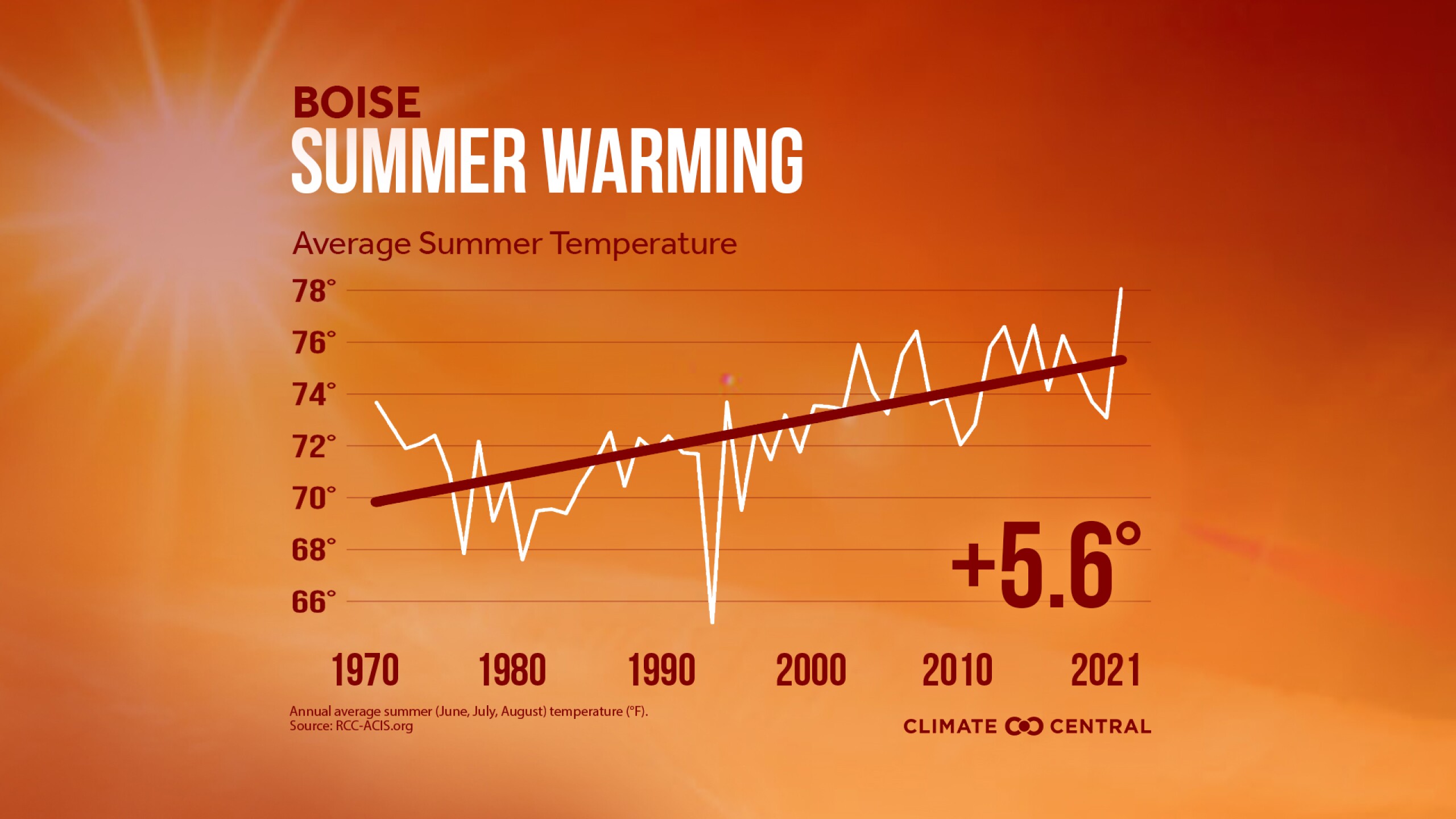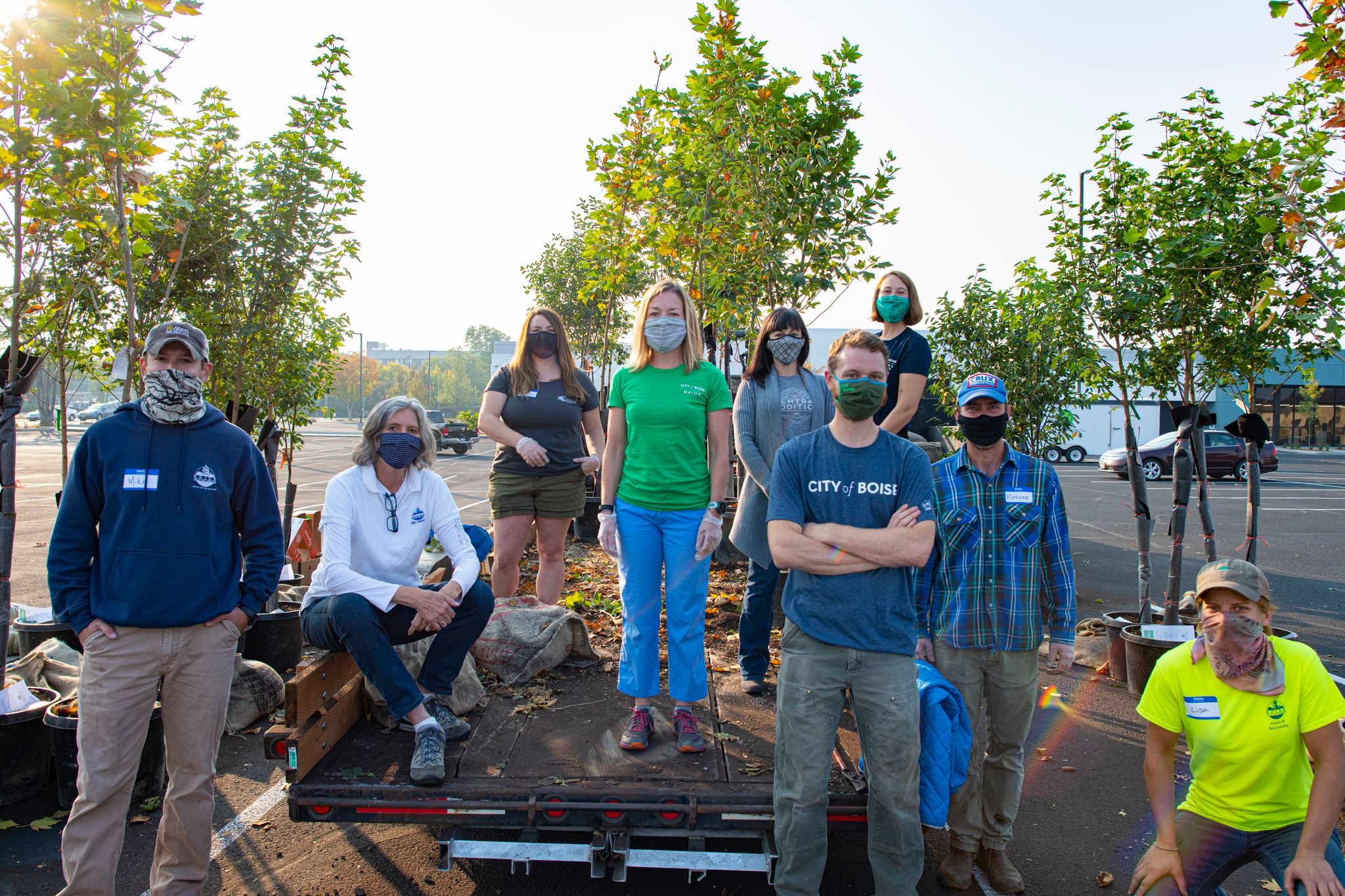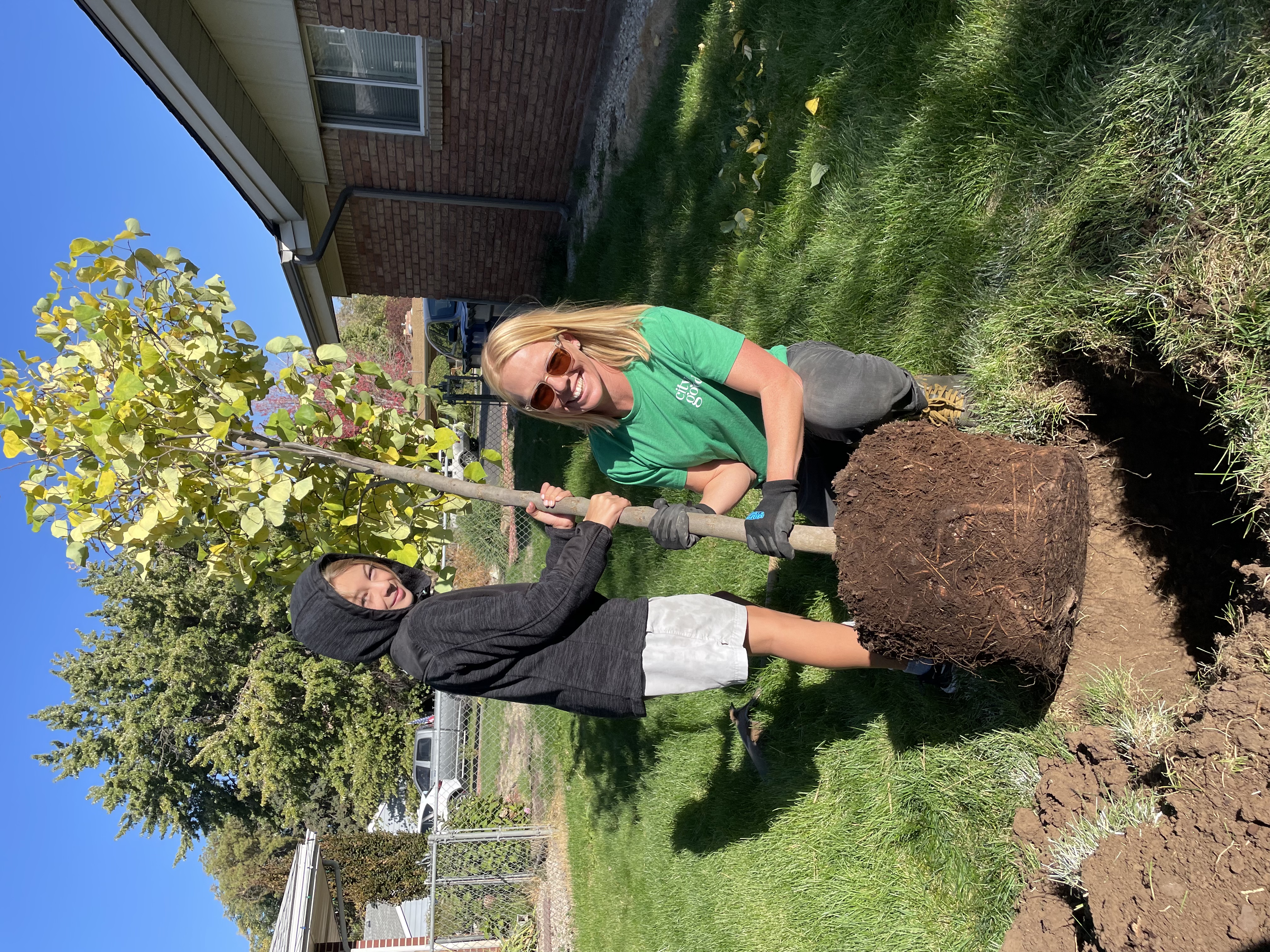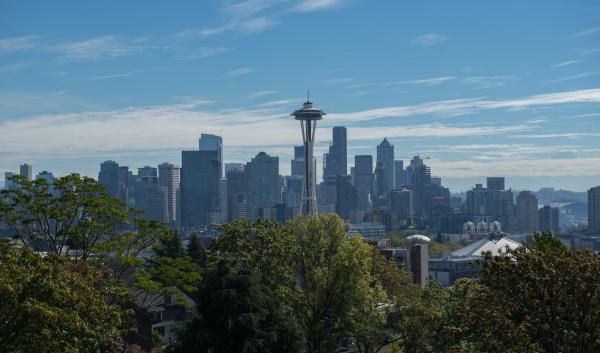Climate change is raising temperatures and increasing the likelihood of extreme heat events across the Northwest. Urban areas can experience more impacts from extreme heat than rural areas. However, strategically planted trees and plants can reduce urban heat and energy use while improving air and water quality. To address urban heat in Boise, the City of Boise partnered with the Treasure Valley Canopy Network and The Nature Conservancy on the Elaine Clegg City of Trees Challenge. The Challenge aims to plant one tree per household in Boise (100,000 urban trees), and one forest seedling in an Idaho forest per Boise resident (235,000 forest seedlings).
Estimated Reading Time | 11 minutes
Management Goals | Plant trees to reduce heat in urban neighborhoods in Boise, Idaho and to restore Idaho forests damaged by wildfire
Audience | Community planners, foresters, land managers, residents
Project Contact | Lance Davisson; Daniel Roop
Project Area | Boise, Idaho
Funding | See funding section in article
Boise is getting hotter
 Average summer temperature in Boise has increased by 5.6°F since 1970. Credit: Climate Central
Average summer temperature in Boise has increased by 5.6°F since 1970. Credit: Climate Central
In Idaho, the average annual temperature has already risen by 2°F since 1900 and is projected to increase by another 3.6°-10.5°F by 2100. Boise, in particular, is one of the fastest warming metropolitan areas in the country. The average annual number of 100°F days in Boise has risen from 2 to 8.1 days since the 1940s, and average summer temperatures have risen by 5.6°F since 1970. Heat waves, like the 2021 heat dome, are also on the rise.
Urban areas with many buildings, roads, and other infrastructure absorb, retain, and emit more heat than natural landscapes. Urban heat islands (urban areas with higher temperatures) can develop where there are many structures or limited greenery. During the day, urban heat islands can be 1-7°F hotter than surrounding areas. Nighttime temperatures can be 2-5°F hotter. At a time when Northwest cities are experiencing record-breaking heat waves and high temperatures, urban heat is an important issue to consider.
Extreme heat is not just uncomfortable; it kills more people in the U.S. every year than any other weather event. Extreme heat can also cause dehydration, heat exhaustion, and heat stroke. Many at-risk individuals, such as children, the elderly, and historically marginalized people, lack the resources needed to adapt (e.g., funds or ability to purchase an air conditioner or reach a cooling center). With temperatures rising and extreme heat events becoming more frequent, cities will need adaptation tools that can keep residents cool and safe. The City of Boise and Treasure Valley Canopy Network are using trees as a natural tool to decrease urban heat.
Trees can help reduce Boise’s urban heat
In August 2019, the Boise-based Treasure Valley Canopy Network monitored temperatures throughout Boise to map urban heat. Neighborhoods with fewer trees and more buildings proved to be much hotter than neighborhoods with many trees. Trees and other plants can lower surrounding air temperatures by as much as 10°F—a significant cooling effect that can protect individuals from heat-related illness and death. Trees reduce urban heat in several ways:
- Shade. If you’ve ever walked down a city street on a hot summer day, you know how much relief a little bit of tree shade can bring. Measurements of solar radiation below deciduous trees show the shade from tree canopy allows only 10-30% of radiation to reach the ground.
- Evapotranspiration. When the sun is out, trees and plants take up water from the soil and release some of it through their leaves. Water also evaporates from the soil beneath trees and plants. This process is known as evapotranspiration. Evapotranspiration uses the heat from the air to evaporate water from plants, causing surrounding temperatures to decrease. Evapotranspiration can reduce peak summer temperatures by 2–9°F.
- Reduced energy use. Because trees and plants keep buildings cooler with shade, they reduce use of fans and air conditioners. When fans and air conditioners are used less, they also release less waste heat (heat produced by a machine as it runs) into the atmosphere.
- Improved air quality and lower greenhouse gas emissions. As trees and other plants reduce energy demand, they decrease air pollution and greenhouse gas emissions. Trees are taking up carbon dioxide that would otherwise be released into the atmosphere, thus reducing emissions that contribute to climate change.
What are the goals of the Elaine Clegg City of Trees Challenge?
With climate change bringing hotter, drier weather to the Boise area, Boise City Council President Elaine Clegg wanted to empower citizen climate action through the simple act of planting a tree, which Elaine recognized would also decrease urban heat, mitigate emission of greenhouse gases, and advance social equity. In 2020, Council President Clegg and the City of Boise partnered with the Treasure Valley Canopy Network and The Nature Conservancy in Idaho to launch the City of Trees Challenge. The main goal of the Challenge is to plant 100,000 urban trees across the city, or 1 tree per household in Boise, by 2030. In addition the city and Treasure Valley Canopy Network partnered with The Nature Conservancy and U.S. Forest Service to replant a burned area on the Boise National Forest with 1 seedling per Boise resident. This reforestation effort restores forest habitat and mitigates greenhouse gas emissions.
Treasure Valley Canopy Network Executive Director, Lance Davisson, notes that the goal of the challenge is not just to plant trees, but to, “plan for, plant, and grow trees.” Trees are a long-term investment that require maintenance and care over their lifetime. He emphasizes that, “the right tree must be planted in the right place and for the right reason” to maximize air and water quality benefits, reduce energy costs, advance social equity, and reduce temperatures.
How is the Elaine Clegg City of Trees Challenge meeting these goals?
The Challenge team brought together a diverse group of partners throughout the city, state, and country. These partners included The City of Boise (Climate Division, Public Works and Planning Departments, Parks Department and City Council), Treasure Valley Canopy Network, The Nature Conservancy in Idaho, U.S. Forest Service, Boise Farmers Market, City of Good, and an array of local green industry partners. The Challenge also aligned goals with the city’s Climate Action Roadmap. The City of Boise provided the bulk of the initial funding for the Challenge, along with the Arbor Day Foundation and The Nature Conservancy. Additional information on fundraising can be found below.
In 2020, the Challenge was ready to start getting trees to community members, but first they had to source trees. The Challenge partnered with Boise's Jayker Wholesale Nursery to source trees for Farmers Market Giveaways and large volunteer tree planting events. The Challenge also partnered with Franz Witte, Edwards Greenhouse and Flowershop, and Zamzows to develop a local retail Nursery Coupon Program. The Challenge team orders trees from a variety of local nursery partners as early as possible to make sure they get the trees when they need them.
The forest seedlings used for reforestation on the Boise National Forest are sourced from Lucky Peak nursery, a U.S. Forest Service nursery near Boise. The nursery uses local seeds to grow ponderosa pine and Douglas-fir seedlings for the Challenge.
Getting trees to residents
The Challenge has used a variety of methods to get trees to local residents:
Boise Farmers Market Giveaways
To safely navigate the COVID-19 pandemic, the team worked with the Boise Farmers Market to incorporate tree giveaways into the existing Saturday drive-through Boise Farmers Market. Residents could order their tree through the Market’s online ordering program, pick up their free tree, then return home to plant it themselves. Some of the tree pickups were memorable. Traci Swift, marketing and outreach specialist for The Nature Conservancy, remembers that “the trees were 10-12 feet tall, and one person showed up on a bike. Another had a two-door car with a sunroof where we were able to just drop it straight in.”
 A Boise Farmer's Market Giveaway with the City of Trees Challenge team. Credit: Treasure Valley Canopy Network
A Boise Farmer's Market Giveaway with the City of Trees Challenge team. Credit: Treasure Valley Canopy Network
The Nursery Coupon Program
In 2022, the City of Trees Challenge launched the Nursery Tree Coupon Program. This program allows residents to buy discounted trees from three local nurseries, Edwards Greenhouse and Flowershop, Franz Witte Garden Center, and Zamzows. So far, the partner nurseries have sold 342 trees for the program, resulting in over $17,000 invested back into Boise’s green economy.
The Boise Tree Captains
As the Challenge grew, the team wanted to be more actively involved with site selection, tree planting, and care. They wanted to reduce urban heat islands by planting more trees in hotter neighborhoods with lower tree canopy coverage. So, they developed the Boise Tree Captains Program, modeled after Root Nashville’s volunteer program in Nashville, Tennessee. The Boise Tree Captains Program recruits volunteers dedicated to enhancing the health of their neighborhoods through tree planting, advocacy, and stewardship. Tree captains are trained to match the right tree species to the right place, spread the word about the Challenge, identify potential planting sites in their neighborhoods, help residents with tree selection, educate tree recipients about young tree care, and assist with the City of Trees Challenge planting events.
Tree Captains come from a range of backgrounds and interests. Some received a free tree at the Boise Farmers Market and wanted to give back. Others are high school students preparing for a climate-altered future. Some are retired arborists, using their skills to improve their community. Davisson stresses that, in their first year, perhaps the greatest success of the Boise Tree Captains was their dedication and experience engaging the community and individual neighborhoods. Davisson remarks that, “We didn’t have to teach the tree captains how to campaign for something in their community, they were already really good at that. We just taught them how to plan for, plant, and care for trees.” He says that, “so often what tree planting organizations do is recruit tree people to engage in their community. What we learned is the value of recruiting people-people and community organizers. It was simple to give them the tools and teach them how to plan for, plant, and care for trees.”
Project outcomes
To date, the Challenge has planted over 15,000 urban trees in Boise neighborhoods and over 149,000 forest seedlings in Boise National Forest. Based on these numbers, the team estimates the following ecosystem service benefits over the course of the next 50+ years (these benefits are calculated through a partnership with the iTree Cooperative):
- 39.8 million pounds of carbon removed
- 312,000 pounds of air pollutants removed
- 47.4 million kWh of energy conserved
- 121 million gallons of stormwater captured and cleaned
In its first three years, the City of Trees Challenge is already having a positive effect across the city and presents an opportunity for citizen climate action and collective growth of the city’s tree canopy. The Challenge is one of several programs supported by the city and Treasure Valley Canopy Network that will help accomplish key goals in the city’s climate action road map and the Boise Community Forestry Strategic Management Plan. In addition to the Challenge, the city has been investing in sustainable streetscapes and parks downtown that will reduce urban heat, and improve the health and resilience of downtown:
- North 8th St Streetscape – The City of Boise and partners are updating the streetscape on 8th street between Bannock and State Street to include more trees and a dedicated bike lane to create a cooler and safer area for visitors.
- Cherie Buckner-Webb Park – The City of Boise and partners created an urban park at 11th street and Bannock in 2021. Cherie Buckner-Webb Park will increase tree canopy in Boise's downtown, providing a relaxing place during Boise's hot summer months.
The Treasure Valley Canopy Network also provides resources to help residents plan for, plant, and grow healthy trees. Some of these include a tree selection guide and tips for how and when to plant a tree.
In terms of agency involvement, Davisson notes that the Challenge and work of the Treasure Valley Canopy Network is also, “helping the City Parks Department, the Climate Division, Planning Department, and Public Works Division accomplish their goals. Everyone can show quantifiable success through what started as a call to climate action from Boise City Council President Clegg.”
Plans for the future
 Residents and volunteers plant trees during one of the City of Trees tree planting events. Credit: Treasure Valley Canopy Network
Residents and volunteers plant trees during one of the City of Trees tree planting events. Credit: Treasure Valley Canopy Network
In 2023, the City of Trees Challenge will raise greater awareness and plant more trees in neighborhoods where they are needed most, such as urban heat islands and areas with low tree canopy. As such, the Challenge is focused on recruiting residents for the Boise Tree Captains program who live, work, or recreate in the Centennial, Central Bench, Borah, Liberty Park, South Cole, Southwest Ada County Alliance, Vista, West Bench, or West Boise neighborhoods. In addition, although the Challenge normally has a single large planting event in the fall, there will be two large planting events in 2023, one in spring and one in fall.
Davisson notes that if residents are interested in receiving a tree, they can reach out to their neighborhood Tree Captain. If residents cannot plant a tree but would like to help, they can donate to support tree planting.
What advice would you give to a city hoping to implement a similar project?
The Challenge team emphasizes the importance of considering the entire life cycle of a tree when developing a tree planting program. Trees must be cared for over time, requiring investment in urban forestry programs, the local green industry, and practitioners. Identifying funding and tree sources early in the process can help get staff up to speed and provide an adequate budget for the full life cycle of city trees. Davisson comments that, “If someone says they want to assist with funding support, we inform them that it costs $5 to get a seedling planted in the forest and $400 for [the life cycle of] one urban tree.” Communicating the true cost of tree planting and care can help potential funders understand that the Challenge is more than just a tree planting program.
The team also recommends reaching out to other cities for help and guidance. The City of Trees Challenge modeled much of their work on Root Nashville. “The cool thing about urban forestry in this country is that most of us want other people to learn from our programs and ideas and use what they learn to adapt a program to serve their local community,” Davisson adds.
Above all, Davisson, Swift, and Roop all stress the importance of strong, local partnerships. “Every problem we’ve solved is because we’ve had a partner that’s willing to dig deep and find a way to make it work,” remarks Davisson. For example, legal restrictions prevent city volunteers from planting trees on private land. In response, the Challenge partnered with Boise’s City of Good, a non-profit organization that provides volunteers to help plant trees. In 2022, over 60 trees were planted by City of Good volunteers in partnership with TV Canopy Network, City of Boise, and Boise Tree Captains. In another example, partnerships with local nurseries, like Jayker Wholesale Nursery, make sourcing trees easier and more affordable. The team emphasizes “leaning on your partners, building an awesome team, and having fun.”
Climate change tools used
The City of Trees Challenge uses several climate change tools in their work.
- iTree delivers current, science-based, peer-reviewed estimates of tree benefits from the U.S. Forest Service to all types of users with free tools and support.
- American Forests and U.S. Forest Service Vibrant Cities Lab arms people with the most current and comprehensive resources related to greening cities. The website, managed by American Forests and the U.S. Forest Service, helps people create, implement, and fund their urban forestry plans and related programs.
- American Forests Tree Equity Score Tool provides a social-equity-focused narrative, goals, and a guide path for building understanding, commitment, and action around Tree Equity.
- The Climate and Economic Justice Screening Tool is a geospatial mapping tool to identify disadvantaged communities that are marginalized, underserved, and overburdened by pollution.
- Treasure Valley Canopy Network Heatmap provides a view of temperatures throughout Boise and highlights neighborhoods that are most vulnerable to extreme heat.
- City of Boise’s Clean City Index, an internal city GIS planning tool, developed as part of Mayor McLean’s City of Boise Climate Action Road Map that helps city staff and partners target neighborhoods of greatest need for tree canopy due to high urban heat, low tree canopy, and demographic factors.
Funding
- USDA Forest Service Urban and Community Forestry Program delivers nature-based solutions to ensure a resilient and equitable tree canopy where more than 84 percent of Americans live.
- USDA Forest Service Reforestation Program provides funding for tree planting on national forests.
- City of Boise funded a substantial portion of the City of Trees Challenge.
- Arbor Day Foundation provided funds for forest seedlings and the spring planting of many urban trees.
- The Nature Conservancy provides funds to the forest seedling side of the project through private donors.
- Locally, private funders, nonprofits, and even a local t-shirt company raised money for the City of Trees Challenge.
City of Trees Challenge – This webpage serves as the hub for the City of Trees Challenge, with information about ongoing projects, StoryMaps, and a map of community-planted trees.
It’s Getting Hot: City of Trees Challenge Urban Heat Island StoryMap – This StoryMap explores the tree planting projects ongoing to make Boise a cooler, healthier city.
2022 Boise City of Trees Challenge Impact Report – This impact report details the successes and challenges of 2022 for the City of Trees Challenge.
Heat Watch Report for Treasure Valley, Idaho – This report describes the results of a study of urban heat in Boise, Idaho.
Vibrant Cities Lab Urban Forestry Toolkit – This U.S. Forest Service step-by-step guide provides resources for implementing urban forestry in your community, including how to plan, build, protect, and sustain urban forests.
Plant a Tree and Save a Life? – This USDA Forest Service Pacific Northwest Research Station Science Findings article explores the impact of tree planting on nonaccidental mortality in Portland’s 140 census tracts.
Reducing Urban Heat Islands: A Compendium of Strategies – Trees and Vegetation – This Environmental Protection Agency compendium describes the causes and impacts of summertime urban heat islands and promotes strategies for lowering temperatures in U.S. communities.
Seedlot Selection Tool – This U.S. Forest Service Tool assists land managers in considering climate change while planning reforestation and restoration efforts.




